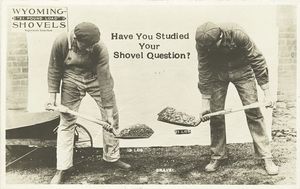It used to be rare that more than a couple of sentences at a time were cut from drafts of this newsletter. For years I wrote mostly in bulleted lists, making it easy to include things that didn’t really fit with the rest of the issue. But as we have focused more on in-depth, long-form writing, the quantity – and quality – of text on our cutting-room floor has increased.
Take, for instance, the piece I wrote recently about the advent of the automobile age. It's a topic that I have complicated feelings on, and one on which a ton of other writing already exists. As a result, my research went down a few rabbit holes that ended up feeling just a little too tangential for the main text – and just a little too meaty for the “scope creep” section.
So today I’d like to share two items from the SOW cutting room floor. The first one (on how Ford used railroads and “driveaways” to ship Model Ts to customers) is free to all readers, but the second (on how modern road surfaces developed) is reserved for Supporters and Members of Scope of Work. If you regularly read this newsletter and value the work we do, please join them; I promise it’ll feel good 💞.
Model T Logistics
As I wrote in my piece on how the automobile affected the rubber industry, the rubber companies that emerged after the Model T were vertically integrated affairs, which managed their own supply chains from tree to tire tread. Ford, on the other hand, let customers handle their own shipping: The company typically sold cars free on board (the incoterm commonly abbreviated as F.O.B.), meaning that customers and dealers needed to either pick up their new cars at the factory, or arrange for a shipper to do so. In other words, Ford wasn’t responsible for distributing products to customers, and so his description of mass production in the 1926 Encyclopaedia Britannica lacked detail on that side of the equation.
Model Ts were produced on Piquette Avenue from 1908 to 1910, when Ford moved to a new Albert Kahn-designed factory in Highland Park. Model Ts were produced at a rate of one every three minutes, and needed to leave the factory as quickly as possible so as not to build up excess inventory. Both factories were directly adjacent to railroad tracks, and it appears that many, if not most, Model Ts were all shipped out via rail – a process that required the automobiles to be partially disassembled almost as soon as they had been put together. A 1915 “Factory Facts” booklet published by Ford gives the reader a virtual tour of the loading docks:
One passes the loading docks, where crews of six to eight men each, working as a unit, remove the bodies and wheels from the chassis, and load them into freight cars. So proficient are these loaders that a freight car is loaded in 20 minutes. Approximately 200 loaded freight cars are sent out every day.
The bodies are shipped separate from the chassis, being stood on end in one half of the car and protected from dust by coverings.
The situation had modernized a bit by 1924, when Ford published The Ford Industries:
Only a few years ago seven touring car bodies were the utmost that could be crowded into a standard 36-foot car. A shortage of transportation following the war, as well as a desire to economize, led the Company to develop the system by which bodies are shipped knocked-down to be assembled and finished in the branches. It is now possible to ship 130 to 140 touring car bodies or 60 sedan bodies in a single car…About 500 freight cars go in and out of the Highland Park plant every day and about 400 at River Rouge.
Some Model Ts were shipped complete in rail cars, others were shipped partially assembled in rail cars. Model Ts were shipped overseas as knockdown kits, and to the west coast by ship, and around the upper midwest by barge. For local and local-ish customers, Model Ts were also sold “driveaway,” meaning that the dealer or customer would pick the car up at the factory; you can see a driveaway invoice in this eBay auction.
The point is that Ford relied heavily on the infrastructure of his time, and that infrastructure allowed him to access the latent demand for cheap automobiles. The US was littered with rail lines by the time that Ford began selling automobiles – and though his innovations would in many ways lead to their demise, the railroad was instrumental to finding the mass consumption that he needed.
Macadam
Read the full story
The rest of this post is for SOW Subscribers (free or paid) only. Sign up now to read the full story and get access to all subscriber-only posts.
Sign up now

